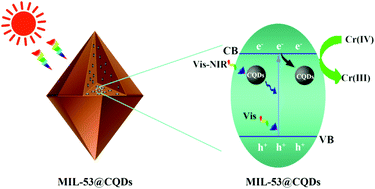Facile generation of carbon quantum dots in MIL-53(Fe) particles as localized electron acceptors for enhancing their photocatalytic Cr(vi) reduction†
Abstract
Metal–organic framework (MOF) photocatalysts have shown promising application in photocatalytic Cr(VI) reduction, but their activities are still restrained by severe charge recombination. To overcome this limitation, herein we propose that the incorporation of cocatalysts as electron acceptors inside MOF pores can provide a better chance to separate the photogenerated electrons, compared with traditional methods to cover cocatalysts on the MOF surface. Following this strategy, we demonstrate a facile method to in situ generate carbon quantum dots (CQDs) as cocatalysts inside a typical MOF photocatalyst (MIL-53(Fe)). The CQDs can serve as efficient localized electron acceptors for separating the photogenerated carriers from the inner metal-oxo clusters among the MOFs, and thus their photocatalytic activities can be greatly improved. Besides acting as electron acceptors, we also reveal that the CQDs can work as photosensitizers for the MOF particles under long-wavelength light irradiation, playing a second role to enhance their activities. The MIL-53(Fe)/CQD composites have been well characterized and their photocatalytic mechanism has been proposed.



 Please wait while we load your content...
Please wait while we load your content...